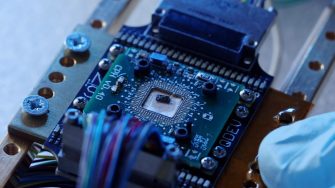
Quantum electronics, topological electronics and quantum computing
Project ID: 148
Supervisor(s): Alex Hamilton
Researchers within the QED group are investigating the electrical and optical properties of nanometer scale semiconductor devices, for future low power and quantum information applications. The group makes its own quantum semiconductor devices here at UNSW, and uses a variety of electronic and optical probes, at milliKelvin temperatures and in strong magnetic fields, to further the understanding of quantum electronics.
We have experimental projects available in three main research areas:
- One aspect of our work is to understand the properties of valence band holes in semiconductor nanostructures. It has been known for over 100 years that electricity is semiconductors is carried by negatively charged electrons and positively charged holes. However our understanding of the quantum mechanical properties of holes in nanoscale electronic devices is far from complete, despite the fact that your mobile phone contains billions of transistors that use holes. This is because although undergraduates are often taught that valence band holes are essentially just heavy electrons, with a positive charge and a positive effective mass, holes are spin-3/2 particles whereas electrons are spin-1/2. This leads to very unusual properties - for instance, whereas electrons have a well defined dipole moment that couples their spin to an externally applied magnetic field, holes also have quadrupole and octopole moments that have no equivalent in electrons. These unique spin properties have led to proposals for novel spin based hole transistors, that could run much faster and with lower power than conventional devices that rely on the charge of electrons, as well as new types of quantum bits for quantum information applications. Students projects are available to fabricate and study holes in quantum wires and quantum dots.
- A second theme of our work is the study of new two-dimensional topological materials, in which the electronic properties are determined by the topology of the bandstructure and the nature of the surfaces and interfaces, rather than by the properties of the crystal (see the 2010 Nobel prize in Physics announcement about 2D materials, and the 2016 Nobel prize in Physics announcement for further information on topological materials). The ultimate aim of this research, which is a key part of the new Australian Research Council Centre of Excellence for Future Low Energy Electronics Technologies (FLEET), is to develop new electronic materials and devices in which topological protection reduces unwanted power dissipation.
- An underpinning theme of our work is the development of new nanofabrication technologies for making advanced quantum devices. Students would work hands-on, using advanced research tools, to try out new methods of making quantum devices, and then perform a variety of electronic and scanning probe measurements to image and characterise the devices they have fabricated.
More details of QED research projects are on our website at: http://www.phys.unsw.edu.au/QED
Previous undergraduate students in the QED group have published their work in journals such as Applied Physics Letters and Physical Review B, and presented their work at major conferences. Motivated students with good lab skills and above average grades are encouraged to apply.
